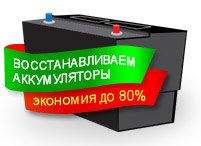Long since “SWEL Energy Ltd.” has been investigated the problems of electrochemical cell efficiency improvement. We have worked out an algorithm which helps to reduce internal resistance of a electrochemical cell during its charge or discharge, and we have obtained numerous experimental data which prove the practical perspective of this algorithm.
The internal resistance of an electrochemical cell, for example, of an accumulator, is a sum of active (ohmic) resistance and so called polarization resistance related to complex electrode reactions. The size of accumulator ohmic resistance is defined by its construction and cannot be reduced. On the contrary, the polarization component can be dramatically directly during charge or discharge of the accumulator.
The most important feature of our algorithm is the separation in time of electric and chemical processes with the help of a special external effect on them (periodic connection and disconnection of an electrochemical cell to/from load or external power supply). Optimizing the parameters of this effect, it’s possible to dramatically reduce the polarization component of internal resistance in an electrochemical cell and significantly increase the efficiency of energy extraction and redistribution. This algorithm can be realized during charge as well as discharge of an electrochemical cell. The results, obtained in our experiments, prove that effective energy capacity of an electrochemical cell can be increased by 15% - 50% according to its type and operating mode.
On the basis of the above mentioned algorithm of internal resistance decrease in an electrochemical cell, we have worked out prototypes of electronic devices realizing this algorithm during charge and discharge of accumulator batteries of different types.
Thus, in July and August 2012 we conducted series of experiments in order to improve the discharge capacity of sealed lead-acid batteries Solby SL12-7 (12 V, 7 A∙h) which were a part of UPS with nameplate load capacity 700 W. The main point of the first experimental stage was to charge these batteries with the help of modified effective charging device “SWEL-ECD”. The essence of the second stage was to conduct life tests by the way of multiple charge and discharge battery cycles in a standart UPS (without “SWEL-ECD”).
Stage 1. Modified device “SWEL-ECD” was connected between UPS proper charging device and examined accumulator batteries. It provided the charge of three accumulator batteries Solby SL 12-7, connected in series, up to rated (nameplate) capacity. There is no gassing during the process which corresponds to battery floating mode. The tests were conducted with two battery sets – testing set and checking set. The accumulator batteries in both sets were produced by the same manufacturer and were from the same lot. Testing and checking battery sets were located in the same UPS in turns. The following parameters were measured during the tests: UPS output power, UPS operation time at the given power level; the power extracted directly from the accumulator bank; voltage on the output of accumulator bank; temperature on the surface of one of the tested accumulator batteries.
The averaged discharge curves (Fig.2) for the testing and checking batteries were built upon the data obtained during the tests.
Stage 2. After the first experimental stage the tested accumulator batteries were sent to “Energy technologies CJSC” in order to conduct life tests. About 50 charge-discharge cycles were conducted during a month period: a UPS with a tested batteries set installed on it, was charged in a standard mode (by its own charger) and then discharged to 600 W load. Average discharge current of the battery in such operating mode was about 3C, depth of discharge (till the moment of programmed UPS load cutoff) reached about 30% of the accumulator battery rated capacity.
The following results were obtained during the experiments:
• the UPS working time with the load 550 W in case of battery charge with “SWEL-ECD” increases by 60% – 65% in comparison with a standard charging mode (Fig.2);
• in the following charge-discharge cycles executed only in standard mode, without “SWEL-ECD” device, the discharge capacity of testing batteries stably exceeded discharge capacity of checking batteries by 40% – 50% (Fig.2);
• life tests at discharge capacity 600 W didn’t reveal degradation of the examined batteries (Fig. 3). Some reduction of mesured battery discharge capacity is associated with significant (12-15°С) drop of average daily environmental temperature during the experiments (temperature dependence of Solby SL 12-7 battery capacity is about 0.5%/°С);
• It means that improvement of active mass surface structure obtained during prior “treatment” by “SWEL-ECD” device, has a permanent character.
The new battery charging method provides maximum efficiency in case of deep prior discharge of accumulator battery and its following charge up to full nameplate capacity by “SWEL-ECD” device.
For more details about the experiments visit our web site: www.swel-energy.com.
The use of effective charging device “SWEL-ECD” during charge of sealed lead-acid accumulator batteries significantly enlarges the working surface of battery active mass and improves its structure. Our experiments show that this improvement has a stable and constant character. First of all, surface enlargement provides smaller density of charging and discharging currents, which permits, for instance, a much more effective discharge of the battery by high currents. Secondly, it leads to the increase of gassing threshold during charge, which, in turn, allows to increase charging voltage during floating operating mode of accumulator battery, that is, provides the possibility for additional increase of battery charging and discharging capacity.
As the result, the energy characteristics of lead-acid accumulator batteries can be improved by 30%–50%. In perspective, the efficiency can be even higher in case of use of combined charging-discharging device based upon the “SWEL-Energy” algorithm.
This innovative technology can be successfully used in uninterruptible power supplies and power backup systems, as well as in many other economic sectors where accumulator batteries and other electrochemical cells are used.
Fig.1. Advantages of “SWEL-ECD” use in UPS.
Fig.3. Life tests of accumulator batteries treated with “SWEL-ECD” device, as part of the UPS unit.



